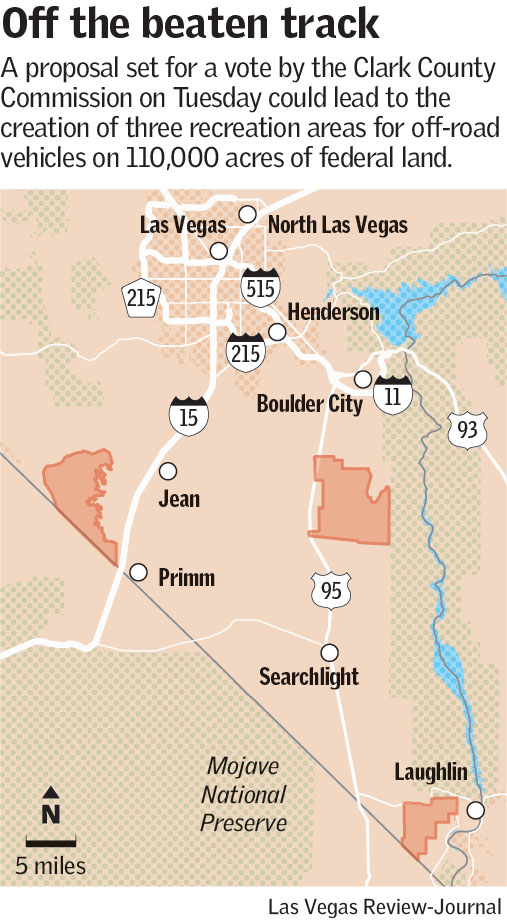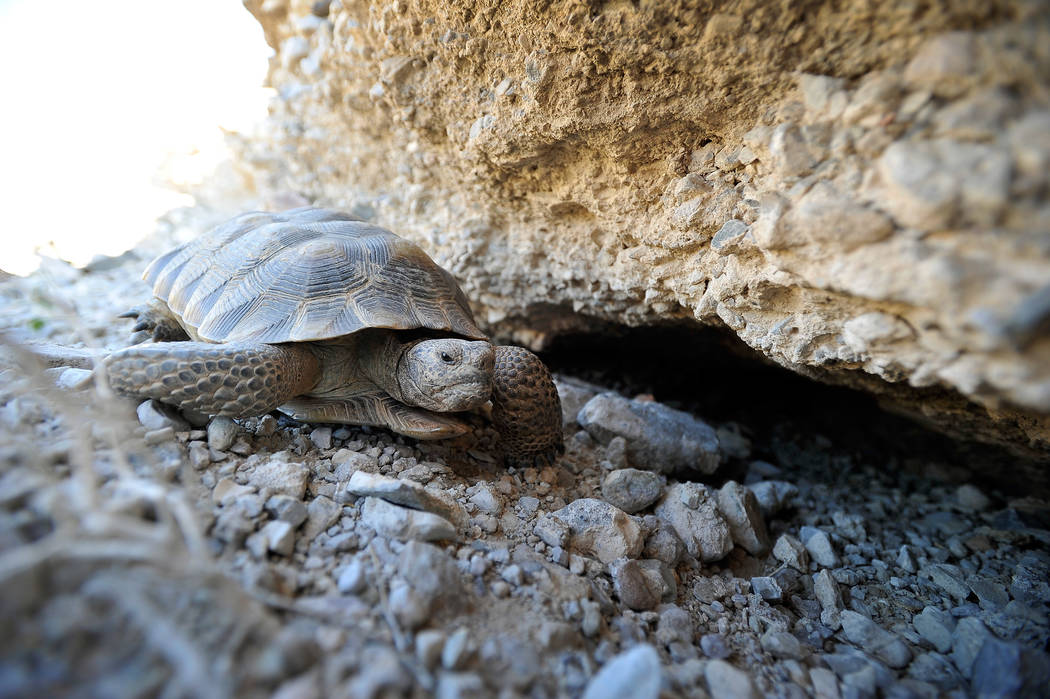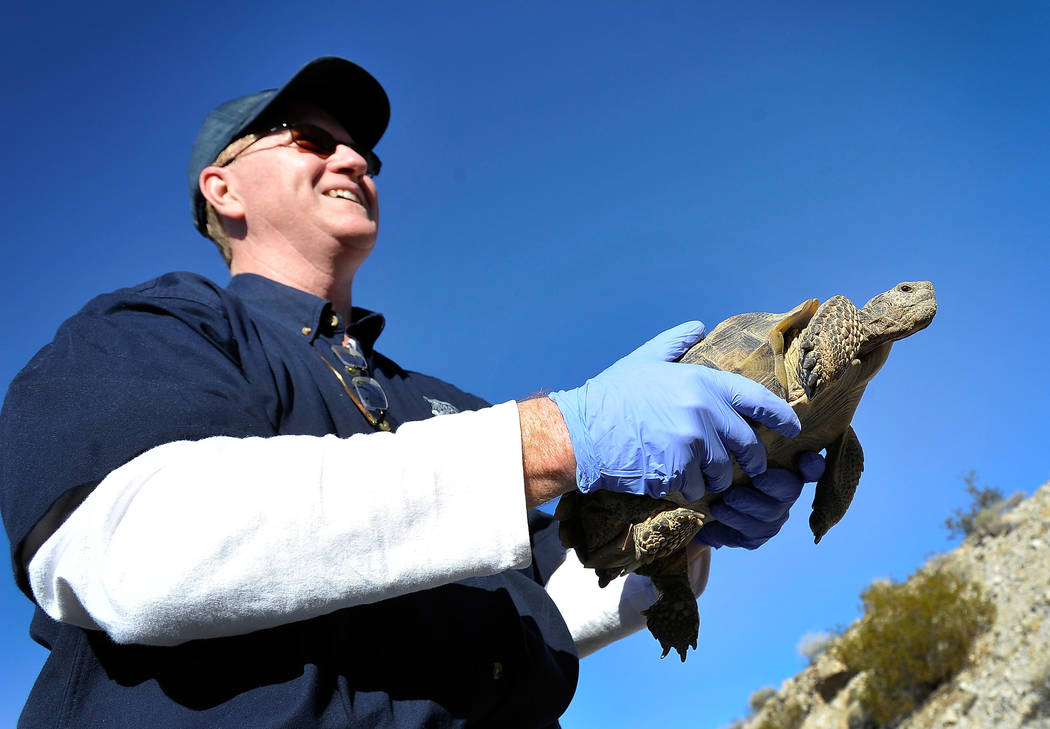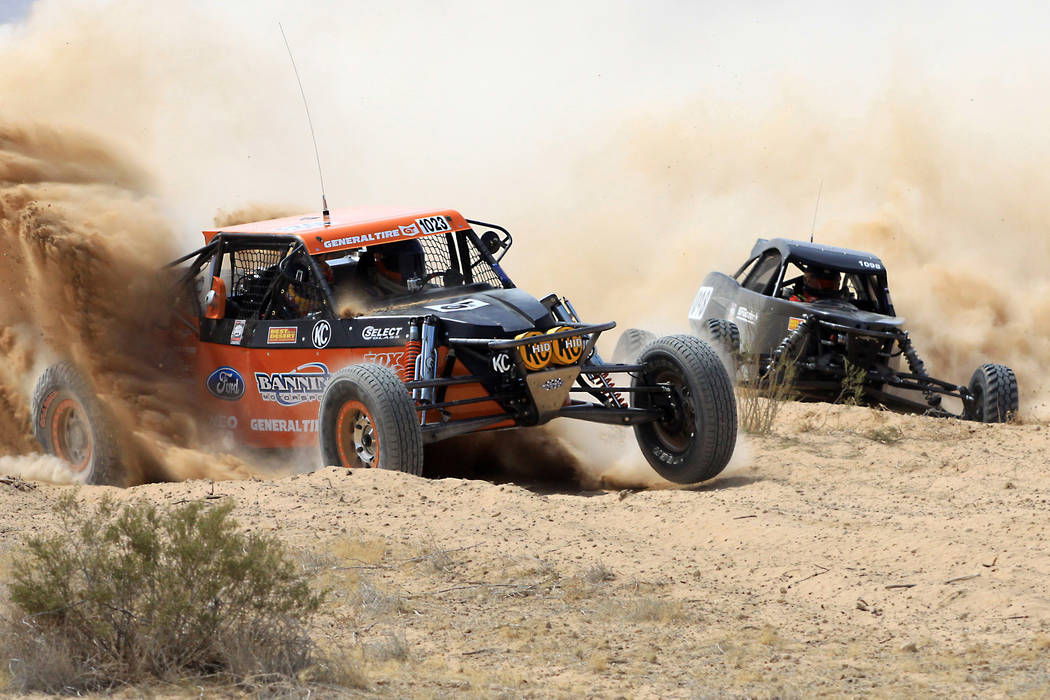Off-roaders fume over Clark County plan to set aside land
A proposal set for a vote by the Clark County Commission on Tuesday could lead to the creation of three recreation areas for off-road vehicles on 110,000 acres of federal land in Southern Nevada.
The plan is meant to appease off-road groups angered by a resolution passed by commissioners last year seeking more federal land for development while closing off some environmentally sensitive areas.

But the proposed recreation areas are already being blasted by some off-roaders and environmentalists.
“They’re taking away the steak and giving us a hot dog,” said Ken Freeman, president of the nonprofit Southern Nevada Off Road Enthusiasts. “It’s not a win for us. It’s going to hurt us.”
The recreation areas cover 50,080 acres near the town of Nelson, south of Boulder City; 40,754 acres along the state’s southern boundary from Primm to Sandy Valley; and 19,811 acres northwest of Laughlin.
Freeman said his group isn’t thrilled about any of those locations, none of which compares with the prime patch of desert off-roaders are poised to lose east of Interstate 15 between Sloan and Jean. That area hosts at least 20 off-road races a year, he said. The county would prefer to see new commercial businesses and residential neighborhoods built on almost 45,000 acres there.
The resolution passed by commissioners in June calls for federal legislation that would open up that and other public land for development and set aside about 376,000 acres for conservation, among other provisions.
Off-roaders turned out in force to oppose the county’s congressional wish list, prompting the commission to create something called the Clark County Off-Highway Vehicle Advisory Committee to craft a compromise. But Freeman, who served on the committee, said county officials wouldn’t budge an inch when it came to the area between Sloan and Jean.
He said he hasn’t talked to anyone in the off-road community who is happy with what the county came up with instead.
Designed by committee
According to Freeman, the Sandy Valley site includes a lot of steep, inaccessible terrain directly adjacent to an area where federal officials have released thousands of desert tortoises over the years, while the Nelson site is considered critical habitat for the protected reptile. That will almost surely mean tight seasonal restrictions on when off-road events can be held there, he said.
County Air Quality Director Marci Henson, who headed up the land planning effort, seemed surprised by Freeman’s comments. She said the three recreation areas were developed in direct consultation with the advisory committee, and all of its members — Freeman included — ultimately voted in favor of what’s being presented to the commission on Tuesday.
Henson said the Nelson and Laughlin sites already see heavy use by off-roaders, while the Sandy Valley site represents a brand new playground for all-terrain vehicles. Racing enthusiasts might prefer to see more land designated for off-road recreation, she said, but she thinks it’s significant that areas as large as these could be permanently set aside for that purpose through an act of Congress.
As for the tortoises, she said a mountain range separates the proposed recreation area near Sandy Valley from the U.S. Fish and Wildlife Service’s Large Scale Translocation Site, where more than 9,100 tortoises were set free between 1997 and 2014.
Critics pan process
Conservationist Kevin Emmerich isn’t just worried about the reptiles.
He said it looks to him like county officials are trying to skirt the federal environmental review process altogether by asking Congress directly to parcel out public lands on their behalf.
“I think the public is being short-changed,” said Emmerich, co-founder of the Nevada-based environmental group Basin and Range Watch. “If the (Bureau of Land Management) turns that land into areas where people can just drive all over the place, there are going to be impacts.”
But Henson said there will be no shortage of public participation and federal oversight, should the county’s land proposals advance. “There’s nothing we’re doing that’s exempted by (the National Environmental Policy Act),” she said.
Patrick Donnelly, Nevada director for the Center for Biological Diversity, said he has numerous concerns about the off-road recreation areas, but what troubles him the most is the process that was used to draft last year’s resolution and this latest proposal.
“The county is going about this in an underhanded fashion. They are leaving out stakeholders and limiting public involvement, and they are trying to do this without anyone noticing,” Donnelly said. “They should throw the whole resolution out and start over again. And this time, do it properly.”
Contact Henry Brean at hbrean@reviewjournal.com or 702-383-0350. Follow @RefriedBrean on Twitter.
Bill being drafted
Clark County officials say they are close to finishing draft language of a sweeping federal lands bill that could open new areas to development.
County Air Quality Director Marci Henson, who is leading the land planning effort, said she hopes to have the draft bill done by the end of the month.
In June, county commissioners approved a resolution outlining what will go into the proposed legislation. That wish list included 45,000 acres of new land for development south of the Las Vegas Valley, about 376,000 acres of new protected areas, a 41,000-acre expansion of the Moapa River Indian Reservation and a host of other land and fee transfers.
Henson said she doesn't know when the measure might be introduced in Congress by a member of Nevada's delegation.
She expects the legislation to start as a stand-alone bill, but she said it could wind up being packaged with something else or tucked into a larger spending bill like the National Defense Authorization Act.
"Really the county's strategy is whatever fits best," Henson said.




























